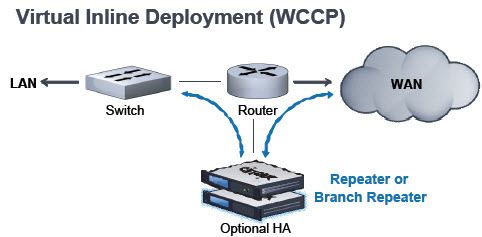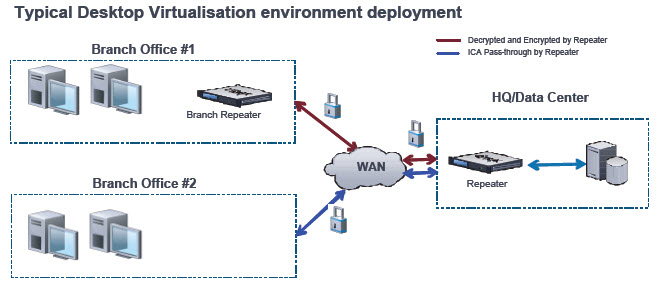Introduction
Citrix Branch Repeater™, available as a physical, virtual and a software (Repeater plug-in) appliance, is a service-centric WAN optimization solution that accelerates, controls and optimizes all services-desktops, applications, multi-media and more—for branch and mobile users while reducing IT costs.
How the branch repeater works depends upon how it has been deployed. In an inline deployment (see Figure 1), the Branch Repeater appliance uses an accelerated bridge (two Ethernet ports). Packets enter one Ethernet port and exit through the other. As far as the rest of the network is concerned, it is as if the Branch Repeater is not present, its operation is completely transparent.

Figure 1 : Inline deployment of the Citrix Branch Repeater
If inline deployment is not possible, the branch repeaters can be deployed through a virtual inline model. This is achieved via policy-based routing or WCCP redirection, such that traffic of particular types is sent to the branch repeaters of the organization.

Figure 2 : Virtual inline deployment of the Citrix Branch Repeater
Figure 3 shows the typical ICA deployment option. Typically, connectivity to different branch offices varies and WAN optimization may not be required for every site. This “mixed approach” is possible with the branch repeater as the appliances detect each other automatically and apply optimization as necessary. However, in all cases there is end-to-end encryption traffic.

Figure 3 : ICA deployment option
If deployed in the SSL deployment mode, the branch repeater can accelerate SSL traffic. It does this by splitting the connection into three encrypted segments: client to client appliance, appliance to appliance, and data center appliance to server. In general, the data center appliance masquerades as the server by hosting its security credentials, allowing it to act on the server’s behalf.

Figure 4 : The SSL deployment mode
This way, the branch repeater enables server and desktop application virtualization services to be delivered quickly and efficiently to branch offices and mobile users over wide area networks (WAN). If these application users complain of slowness in access, administrators must be able to promptly and precisely pinpoint the root-cause of the slowness – is it the non-availability of the branch repeater? is it because of poorly configured QoS thresholds on the branch repeater? Or is it because of inefficient service class policies defined for the branch repeater? With businesses relying heavily on branch offices to serve customers, to be near partners and suppliers and to expand into new markets, any delay in isolating the source of performance problems with the branch repeater will automatically translate into business losses. If this is to be avoided, the overall performance of the branch repeater has to be continuously monitored and deviations from norms should be brought to the attention of administrators. This is where eG Enterprise helps administrators.



